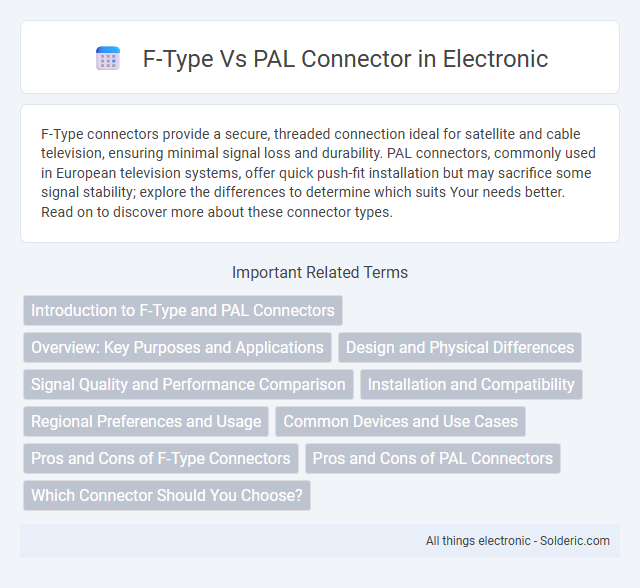F-Type connectors provide a secure, threaded connection ideal for satellite and cable television, ensuring minimal signal loss and durability. PAL connectors, commonly used in European television systems, offer quick push-fit installation but may sacrifice some signal stability; explore the differences to determine which suits Your needs better. Read on to discover more about these connector types.
Comparison Table
| Feature | F-Type Connector | PAL Connector |
|---|---|---|
| Usage | Cable TV, satellite | Analog video signals, CCTV |
| Connector Type | Threaded coaxial | BNC-style bayonet |
| Signal Type | RF (Radio Frequency) | Composite video |
| Frequency Range | Up to 1 GHz+ | Up to 400 MHz |
| Impedance | 75 Ohms | 75 Ohms |
| Locking Mechanism | Thread screw | Bayonet twist |
| Common Applications | Satellite dishes, cable modems | Security cameras, video equipment |
Introduction to F-Type and PAL Connectors
F-Type and PAL connectors are widely used for coaxial cable connections in television and video applications, with F-Type connectors primarily utilized in North America for cable TV, satellite, and cable modems. PAL connectors are more common in Europe and parts of Asia, designed for terrestrial television and VCR connections, featuring a distinct bayonet locking mechanism. Both connectors ensure signal integrity but differ in design, compatibility, and regional preferences in broadcast infrastructure.
Overview: Key Purposes and Applications
The F-Type connector is primarily used for cable television, satellite TV, and broadband internet connections due to its threaded design that ensures a secure, weatherproof connection. PAL connectors, commonly found in European television systems, are designed for analog video signal transmission in older TV sets and some CCTV systems. Understanding your device's compatibility is crucial for selecting the right connector to maintain signal quality and system performance.
Design and Physical Differences
F-Type connectors feature a threaded, screw-on design providing secure connections commonly used for cable TV and satellite signals. PAL connectors have a bayonet-style locking mechanism mainly found in European television systems, offering quick attachment and release. Understanding these distinct designs helps you select the appropriate connector for your equipment's compatibility and installation requirements.
Signal Quality and Performance Comparison
F-Type connectors provide superior signal quality for high-frequency applications up to 3 GHz, making them ideal for satellite and cable TV systems due to their low signal loss and excellent shielding performance. PAL connectors, commonly used in European TV antenna systems, are designed primarily for analog signals and typically operate effectively up to 1 GHz, resulting in higher signal degradation and susceptibility to interference. The enhanced performance of F-Type connectors in maintaining signal integrity over longer cable runs results in clearer picture quality and more reliable digital transmission compared to PAL connectors.
Installation and Compatibility
F-Type connectors offer straightforward installation with a screw-on design suited for RG6 coaxial cables, ensuring a secure and weather-resistant connection ideal for satellite and cable TV. PAL connectors, predominantly used in European and Asian television systems, require a push-on or twist-lock mechanism compatible with older coaxial cables, often favoring analog TV setups. Compatibility varies as F-Type connectors support digital signals and HD content, while PAL connectors are typically found in legacy systems and analog broadcasts.
Regional Preferences and Usage
F-Type connectors dominate North American cable and satellite TV installations due to their superior shielding and ease of use, ensuring a reliable signal for your home entertainment system. PAL connectors are predominantly used in European and Australian regions, favored for their bayonet-style locking mechanism that ensures a secure fit in broadcast and professional video equipment. Understanding these regional preferences helps you choose the right connector for compatibility and optimal performance in your geographical area.
Common Devices and Use Cases
F-Type connectors are predominantly used in cable television systems, satellite TV receivers, and broadband internet modems, ensuring secure connections for coaxial cables carrying RF signals. PAL connectors are commonly found in older analog video equipment, such as vintage televisions and video recorders, facilitating composite video connections in regions using the PAL broadcast standard. Both connectors play crucial roles in specific audiovisual setups, with F-Type excelling in RF and broadband applications, while PAL connectors serve legacy analog video interfaces.
Pros and Cons of F-Type Connectors
F-Type connectors offer excellent durability and signal integrity for coaxial cable connections, making them ideal for satellite and cable TV systems with minimal signal loss. Their threaded design ensures a secure and reliable connection, but installation can be challenging without proper tools and may require professional expertise. Although more resistant to interference, F-Type connectors are bulkier compared to PAL connectors, potentially limiting space in tight installations.
Pros and Cons of PAL Connectors
PAL connectors offer affordability and ease of installation, making them suitable for basic television signal connections. However, their lower frequency range and susceptibility to signal loss compared to F-type connectors can affect picture quality in high-definition setups. You should weigh the cost-effectiveness of PAL connectors against the performance demands of your specific application.
Which Connector Should You Choose?
When choosing between an F-Type and a PAL connector, consider your specific cable system and geographical location. The F-Type connector is widely used in North America for satellite and cable TV connections due to its superior shielding and low signal loss, while the PAL connector is common in Europe and often found in older TV and radio setups. Your decision should be based on compatibility with your equipment and signal requirements to ensure optimal performance.
F-Type vs PAL Connector Infographic

 solderic.com
solderic.com